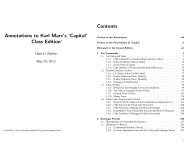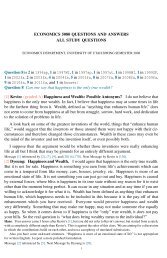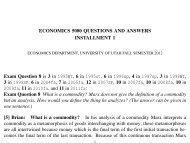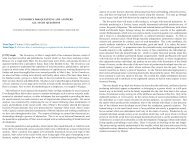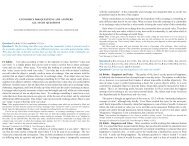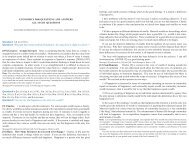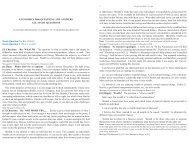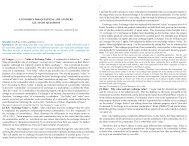Question 1 What did Marx mean with his formu - University of Utah
Question 1 What did Marx mean with his formu - University of Utah
Question 1 What did Marx mean with his formu - University of Utah
Create successful ePaper yourself
Turn your PDF publications into a flip-book with our unique Google optimized e-Paper software.
U <strong>of</strong> <strong>Utah</strong> Econ 5080 2005fa 95<br />
Exam <strong>Question</strong> 148 is 114 in 2001fa, 124 in 2002fa, and 144 in 2004fa:<br />
Exam <strong>Question</strong> 148 Why is the simple value expression asymmetric between coat and<br />
linen?<br />
[612] Gza: graded A extra credit test question. Since we cannot see value because it is<br />
congealed and not materialized, we have to look for an expression <strong>of</strong> value that can allow<br />
comparison for potential exchange. We cannot say that the coat and the linen are inherently<br />
(innately or tacitly) equal since they are not the same. However, as <strong>Marx</strong> illustrates in<br />
<strong>his</strong> expression we can see the value <strong>of</strong> one as in the body <strong>of</strong> the other; the linen in/to the<br />
coat. <strong>What</strong> is key in asymmetric expression is to be aware what a commodity’s value is in<br />
exchange for other commodities. Constructing an expression that allows comparative value<br />
to be explicitly materialized in discourse allows trade to engage in a systemic context <strong>of</strong><br />
equal value. T<strong>his</strong> is essential because one does not trade equal/same commodities. In <strong>his</strong><br />
simple form, <strong>Marx</strong> utilizes one equation: x=a, where a is the equivalent and x is the relative.<br />
The expanded form takes t<strong>his</strong> expression and adds other commodities where all possible<br />
commodities are equated to a single commodity such as linen. Thus, x=a; y=a; z=a, and so<br />
on where a is the equivalent and x,y,z are the relative. The general form allows the role <strong>of</strong><br />
the relative and equivalent to reverse or switch.<br />
Message [612] referenced by [629] and [631]. Next Message by Gza is [821].<br />
[629] Michael: A note on GZA’s answer. GZA,<br />
In your answer [612] the expanded form is crossed up <strong>with</strong> the general form: Your equations<br />
x=a, y=a,..., actually correspond to the general form. One expresses the expanded form<br />
<strong>of</strong> value <strong>of</strong> one commodity “z” as z=a, z=b, z=c, ..., and so on for all the various commodities<br />
which are exchangeable <strong>with</strong> z (<strong>of</strong> course, in explicit proportions).<br />
As you suggested, the simple form <strong>of</strong> value <strong>of</strong> one commodity, in t<strong>his</strong> case z, expresses<br />
the value <strong>of</strong> z in terms <strong>of</strong> the use-value <strong>of</strong> a. So, in the expanded form, which is the simple<br />
form extended, the value <strong>of</strong> z is expressed in terms <strong>of</strong> each <strong>of</strong> the use-values a, b, c, ....<br />
That is, there is no unique commodity (except trivially, where z can only be traded for a)<br />
that assumes the role <strong>of</strong> equivalent in the expanded form. In the general form it’s just the<br />
opposite: Every commodity which assumed the role <strong>of</strong> equivalent in the expanded form now<br />
assumes the role <strong>of</strong> relative form. That is, now the values <strong>of</strong> each <strong>of</strong> commodities a, b, c, ...<br />
are being expressed in terms <strong>of</strong> one use value–z.<br />
One asymmetry in the simple form <strong>of</strong> expression a=x is that commodity a is expressing its<br />
value in terms <strong>of</strong> a use-value–x. But as t<strong>his</strong> expression stands we cannot speak <strong>of</strong> the value<br />
<strong>of</strong> x, because here x is value–is value materialized. (Likewise, if gold is in the equivalent<br />
form it wouldn’t make sense to ask: what is the value <strong>of</strong> w amount <strong>of</strong> gold? But we could<br />
ask: what is the value <strong>of</strong> gold in terms <strong>of</strong>, say, silver? But in that case the silver would be<br />
playing the role <strong>of</strong> equivalent, while gold would be in the relative form.)<br />
So there is an asymmetry inherent in the expression a=x: one (and only one) commodity is<br />
considered only as a value, while the other is considered only as a use-value. Then reversing<br />
the equation just reverses those roles.<br />
Message [629] referenced by [631]. Next Message by Michael is [686].<br />
96 2005fa Econ 5080 U <strong>of</strong> <strong>Utah</strong><br />
[631] Hans: Asymmetry in theory and practice. Gza’s [612] is an excellent answer;<br />
there is a little error at the end <strong>with</strong> the expanded form <strong>of</strong> value, <strong>with</strong> Michael corrects in<br />
[629].<br />
Gza, Michael, and <strong>Marx</strong> himself make a very abstract argument: they explore what it<br />
<strong>mean</strong>s to say that x amount <strong>of</strong> commodity a is worth y amount <strong>of</strong> commodity b, and they<br />
conclude that t<strong>his</strong> <strong>mean</strong>ing is asymmetric.<br />
In the Annotations I tried a more concrete approach which places t<strong>his</strong> abstract value<br />
statement into a practical context. I view the situation as follows: If linen weaver and tailor<br />
exchange 20 yards <strong>of</strong> linen for one coat, then the linen weaver “says” through t<strong>his</strong> transaction<br />
that the 20 yards <strong>of</strong> linen are worth one coat for her, and the tailor says that <strong>his</strong> coat is worth<br />
20 yards <strong>of</strong> linen for him. The asymmetry <strong>of</strong> the simple form <strong>of</strong> value comes therefore from<br />
the fact that the two parties in an exchange have different views <strong>of</strong> t<strong>his</strong> exchange and pursue<br />
different goals <strong>with</strong> it.<br />
The answer which I was aiming for was therefore: the simple form <strong>of</strong> value is asymmetric<br />
because the two parties in an exchange pursue different goals in t<strong>his</strong> exchange. T<strong>his</strong> is by no<br />
<strong>mean</strong>s the only way to answer t<strong>his</strong> question, but I think it provides a helpful perspective for<br />
the understanding <strong>of</strong> the whole section 3 <strong>of</strong> chapter One.<br />
Next Message by Hans is [647].<br />
<strong>Question</strong> 150 is 85 in 1995ut, 87 in 1996sp, 88 in 1996ut, 94 in 1997WI, 92 in 1997ut, 99<br />
in 1998WI, 107 in 1999SP, 134 in 2003fa, 170 in 2007fa, and 182 in 2009fa:<br />
<strong>Question</strong> 150 In the Simple or Accidental form <strong>of</strong> value, which commodity plays an active<br />
role, and which a passive role? Explain what it <strong>mean</strong>s in t<strong>his</strong> situation to be active or<br />
passive.<br />
[338] Keltose: (graded C) Until now I have never thought <strong>of</strong> a commodity playing an<br />
active or passive role in economics. Hans makes a great point, “T<strong>his</strong> is why <strong>Marx</strong> says<br />
that the value <strong>of</strong> the linen is expressed in the ‘use-value’ <strong>of</strong> the coat.” (86) When thinking<br />
about that I believe that the linen in t<strong>his</strong> example plays the passive role, and the coat being<br />
active. The coat is being used, and therefore has the value because <strong>of</strong> its use. The linen is<br />
passive because it can create other uses and values by way <strong>of</strong> the tailer into other goods, (i.e.<br />
blankets, socks). The use-value and the active role is being played by the finished and used<br />
good. T<strong>his</strong> seems only relevant to exchange goods. If there were some use and value in<br />
plain linen, then there would be nothing to compare in exchange. <strong>Marx</strong> explains, “The same<br />
commodity cannot, therefore, simultaneously appear in both forms in the same expression<br />
<strong>of</strong> value.” (86)<br />
Hans: You are making the mistake against which I warned in [73].<br />
Next Message by Keltose is [340].<br />
<strong>Question</strong> 158 <strong>Marx</strong> says that the human labor accumulated in the coat is not visible in the<br />
coat. Is t<strong>his</strong> not obviously wrong? Everybody who sees a coat knows that it is a product <strong>of</strong><br />
human labor, t<strong>his</strong> coat would not exist <strong>with</strong>out the human labor that produced it.



